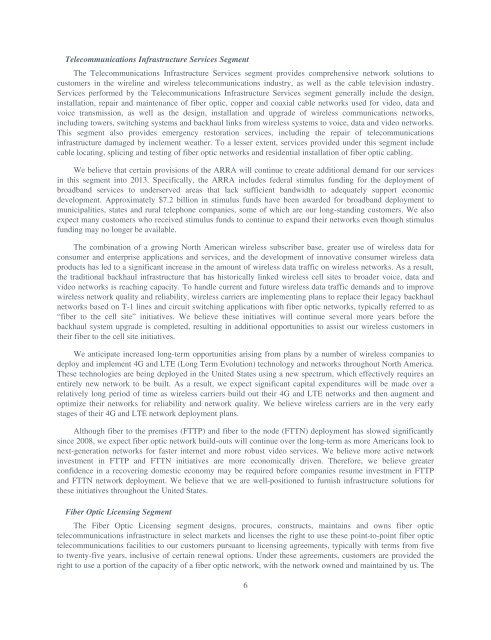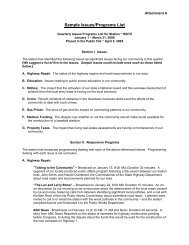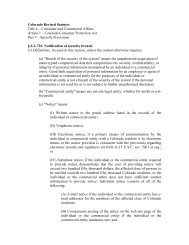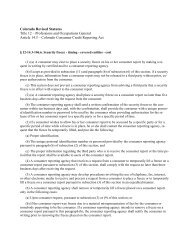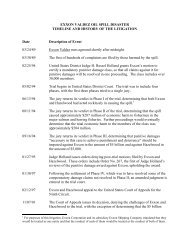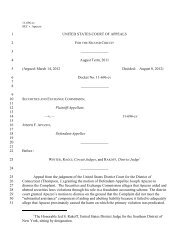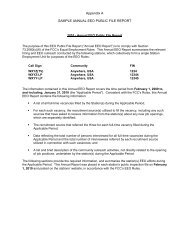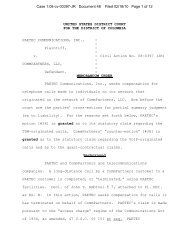QUANTA SERVICES INC, QUANTA SERVICES MANAGEMENT ...
QUANTA SERVICES INC, QUANTA SERVICES MANAGEMENT ...
QUANTA SERVICES INC, QUANTA SERVICES MANAGEMENT ...
Create successful ePaper yourself
Turn your PDF publications into a flip-book with our unique Google optimized e-Paper software.
Telecommunications Infrastructure Services Segment<br />
The Telecommunications Infrastructure Services segment provides comprehensive network solutions to<br />
customers in the wireline and wireless telecommunications industry, as well as the cable television industry.<br />
Services performed by the Telecommunications Infrastructure Services segment generally include the design,<br />
installation, repair and maintenance of fiber optic, copper and coaxial cable networks used for video, data and<br />
voice transmission, as well as the design, installation and upgrade of wireless communications networks,<br />
including towers, switching systems and backhaul links from wireless systems to voice, data and video networks.<br />
This segment also provides emergency restoration services, including the repair of telecommunications<br />
infrastructure damaged by inclement weather. To a lesser extent, services provided under this segment include<br />
cable locating, splicing and testing of fiber optic networks and residential installation of fiber optic cabling.<br />
We believe that certain provisions of the ARRA will continue to create additional demand for our services<br />
in this segment into 2013. Specifically, the ARRA includes federal stimulus funding for the deployment of<br />
broadband services to underserved areas that lack sufficient bandwidth to adequately support economic<br />
development. Approximately $7.2 billion in stimulus funds have been awarded for broadband deployment to<br />
municipalities, states and rural telephone companies, some of which are our long-standing customers. We also<br />
expect many customers who received stimulus funds to continue to expand their networks even though stimulus<br />
funding may no longer be available.<br />
The combination of a growing North American wireless subscriber base, greater use of wireless data for<br />
consumer and enterprise applications and services, and the development of innovative consumer wireless data<br />
products has led to a significant increase in the amount of wireless data traffic on wireless networks. As a result,<br />
the traditional backhaul infrastructure that has historically linked wireless cell sites to broader voice, data and<br />
video networks is reaching capacity. To handle current and future wireless data traffic demands and to improve<br />
wireless network quality and reliability, wireless carriers are implementing plans to replace their legacy backhaul<br />
networks based on T-1 lines and circuit switching applications with fiber optic networks, typically referred to as<br />
“fiber to the cell site” initiatives. We believe these initiatives will continue several more years before the<br />
backhaul system upgrade is completed, resulting in additional opportunities to assist our wireless customers in<br />
their fiber to the cell site initiatives.<br />
We anticipate increased long-term opportunities arising from plans by a number of wireless companies to<br />
deploy and implement 4G and LTE (Long Term Evolution) technology and networks throughout North America.<br />
These technologies are being deployed in the United States using a new spectrum, which effectively requires an<br />
entirely new network to be built. As a result, we expect significant capital expenditures will be made over a<br />
relatively long period of time as wireless carriers build out their 4G and LTE networks and then augment and<br />
optimize their networks for reliability and network quality. We believe wireless carriers are in the very early<br />
stages of their 4G and LTE network deployment plans.<br />
Although fiber to the premises (FTTP) and fiber to the node (FTTN) deployment has slowed significantly<br />
since 2008, we expect fiber optic network build-outs will continue over the long-term as more Americans look to<br />
next-generation networks for faster internet and more robust video services. We believe more active network<br />
investment in FTTP and FTTN initiatives are more economically driven. Therefore, we believe greater<br />
confidence in a recovering domestic economy may be required before companies resume investment in FTTP<br />
and FTTN network deployment. We believe that we are well-positioned to furnish infrastructure solutions for<br />
these initiatives throughout the United States.<br />
Fiber Optic Licensing Segment<br />
The Fiber Optic Licensing segment designs, procures, constructs, maintains and owns fiber optic<br />
telecommunications infrastructure in select markets and licenses the right to use these point-to-point fiber optic<br />
telecommunications facilities to our customers pursuant to licensing agreements, typically with terms from five<br />
to twenty-five years, inclusive of certain renewal options. Under these agreements, customers are provided the<br />
right to use a portion of the capacity of a fiber optic network, with the network owned and maintained by us. The<br />
6


